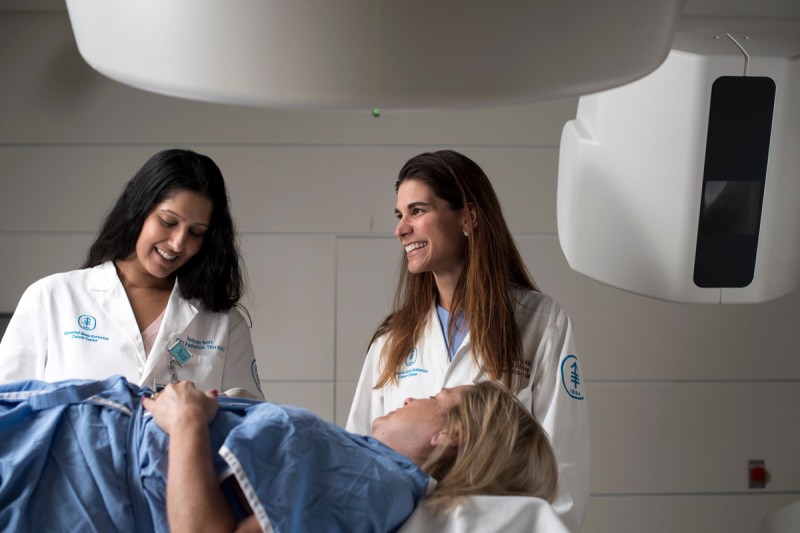
MSK provides radiation treatment for breast cancer at multiple locations, including MSK Westchester. (Shown here: radiation oncologist Melissa Zinovoy, right, and chief radiation therapist Beeban Natt)
Women with a type of early-stage, noninvasive breast cancer called ductal carcinoma in situ (DCIS) face a delicate choice after the tumor is removed. Although the chance of the cancer returning (recurrence) is low, this risk can be further reduced with preventive measures, such as radiation therapy or the drug tamoxifen (Nolvadex®). For each person, it is a question of whether the additional treatment is worth the potential side effects.
Now a study led by Memorial Sloan Kettering radiation oncologist Beryl McCormick shows that for some women with DCIS, radiation can markedly reduce this already-low risk even more. The finding is being presented by Dr. McCormick today at the annual meeting of the American Society for Radiation Oncology.
“This was a much larger impact than we expected,” says Dr. McCormick, who is Chief of the External Beam Radiotherapy Service. She was one of 18 authors on the large study, which involved 629 people and was funded by the National Cancer Institute through the Radiation Therapy Oncology Group (now part of NRG Oncology).
Although the radiation had a bigger effect than expected, that does not mean that women with DCIS should necessarily receive this treatment after surgery. Instead, the finding can help guide discussions between people with cancer and their doctors about whether to pursue additional therapies.
“Radiation does significantly reduce the risk of recurrence, but you are starting with a very low recurrence rate even without radiation,” Dr. McCormick says. “Each person’s DCIS is different, and we encourage doctors to discuss all of the factors in deciding on the best course of action based on the risks, the benefits, and the patient’s own degree of comfort.”
Differing Attitudes toward Risk
DCIS is a very early form of breast cancer that’s confined to the milk ducts, which is why it’s called “ductal.” The study examined the effect of radiation on recurrence in women with “good risk” DCIS, which means the tumors were small and found only on a mammogram or by chance during breast surgery for another reason.
For this study, women who had DCIS removed with breast-conserving surgery from 1999 to 2006 were randomly assigned to receive either whole-breast radiation therapy or observation. Both groups were monitored for a median of 12 years after treatment.
After 12 years, 2.8% of the women in the radiation group had a local recurrence — meaning the cancer returned in the same breast. In women who were observed, the rate of local recurrence was 11.4%. In both groups, about half of the recurrences were DCIS, with the other half progressing to invasive cancer, meaning it had spread to nearby breast tissue.
Dr. McCormick notes that none of the tumors that recurred in either group seemed life-threatening — even the invasive cancers were not the type that spread extensively to lymph nodes or other organs. Because of this, she says that women should talk through treatment decisions with their doctors based on their own preferences.
A typical course of radiation treatment for DCIS involves 16 sessions given over three weeks. Some women may find that committing to this treatment schedule is too difficult or even impossible, says Dr. McCormick, or they feel strongly about avoiding radiation side effects, which can include swelling, pain, skin discoloration, and shrinkage in breast size. Others want to know that they have done everything reasonable to avoid or reduce the risk of ever having to deal with the cancer again.
“All of us have a different definition of what is an acceptable risk,” she says. “For some people with DCIS, an 11% risk of recurrence over 12 years is too high, and they’ll want to do more to make sure it doesn’t come back. For others, it’s small enough over such a long period that they are willing to forgo treatment. That’s why it’s critical that doctors and patients have these discussions.”




